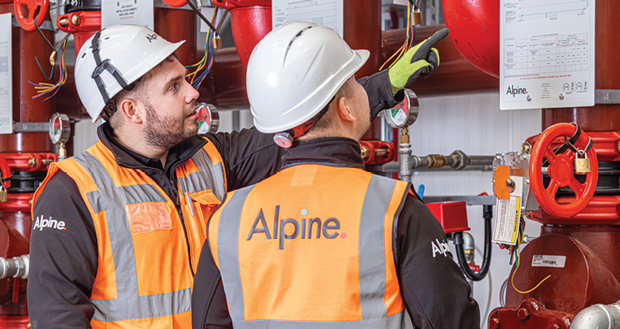 What do FMs need to do to safely remove foam from their fire suppression systems and comply with changing legislation? Mark Thewlis, Operations Director from Alpine Fire, provides a step-by-step guide to the removal of fluorine-containing foam
What do FMs need to do to safely remove foam from their fire suppression systems and comply with changing legislation? Mark Thewlis, Operations Director from Alpine Fire, provides a step-by-step guide to the removal of fluorine-containing foam
On 4 July 2025, the use of C8 Aqueous Film Forming Foam (AFFF) was banned in the UK. The move is part of a continuing effort to reduce the use of long-chain polyfluoroalkyl compounds (PFAS), so-called “forever chemicals” that pose a significant risk to both the environment and public health.
Because they’ve long been used to enhance some fire suppression systems, the changing legislation has a direct impact on facilities, which are now required to plan for the appropriate isolation, removal and certified disposal of any existing C8 foam stocks without delay.
The problem is that safely removing C8 foam from your system isn’t as easy as it sounds. So, what do you need to do to stay on the right side of changing regulations?
STEP 1: ASSESS YOUR RISK
If you’ve not already removed prohibited foams from your system, then now is the time to act. Failure to do so may result in warnings or even potential fines from the Environment Agency. Even if you have already acted, merely switching away from C8 isn’t enough.
This is because you need to ensure all traces of C8 foam are safely removed from your systems, storage and your site.
The best way to do that is to conduct TOP (Total Oxidisable Precursor) Assay water sampling tests to measure the extent of foam migration and detect the presence of banned C8 compounds. Then, once you’re armed with this information, you’ll have a clear idea of the scale of the challenge that you are facing.
STEP 2: PLAN FOR DISRUPTION
Once you know the full extent of C8 contamination on your site, you need to plan ahead for its safe removal.
The process to safely decant existing C8 foams and flush your system can be disruptive. This means it’s important to work with all stakeholders to map timelines, divide responsibilities and ensure you do everything possible to keep disruption to a minimum.
STEP 3: CLEAN YOUR SYSTEM
Now, with the help of an expert, it’s time to fully flush your system to ensure that there are no traces of C8 foam.
This requires you to not only drain your existing system, but also to flush it with clean water to ensure that all traces of residual C8 foam is removed from pipework and components.
Because C8 foam is dangerous to the environment, safe waste collection is vital. You need to ensure that your stocks and the run-off from your system flushes are safely collected to comply with regulations and prevent any contamination to your site or the environment.
STEP 4: DISPOSAL
Once you’ve safely collected your C8 foam stocks, you need to dispose of them. There are strict guidelines that govern the disposal of fluorine-containing foams, so you need to work with an accredited partner to ensure their safe disposal and incineration. Facilities managers should maintain a full audit trail of this process to ensure that they can prove compliance.
Unfortunately, there are simply not enough accredited incinerators to meet current demand for foam disposal, so facilities managers should plan ahead to avoid any potential delays and rising costs.
STEP 5: RETESTING
Once your system has been flushed and your foam safely disposed of, it’s essential to conduct a second round of TOP Assay testing to confirm the complete removal of C8 foam. In some cases, one flush might not be enough, so you’ll have to conduct further work to safely remove any residual PFAS from your facilities.
FROM COMPLIANCE TO COMPETITIVE ADVANTAGE
While this step-by-step guide gives you some insight into the process of identifying and removing C8 foam from your fire suppression system, in reality the process may be much more complex.
What removal looks like for you will depend on how far PFAS have penetrated your systems? What does compliance look like for your facility? And what do you need to do to transition without operational disruption?
No matter how challenging removal may be, it’s important to remember that this is not a choice; it’s a necessity to ensure that you remain on the right side of regulations.
And this won’t be the last time that regulations change. The HSE has already announced a public consultation on further restricting the use of C6 firefighting foams. We’ll have to wait to see the outcome of the consultation, but the message is clear: more restrictions are on the way.
With that in mind, the bigger picture is about more than just compliance; it’s about creating a competitive advantage. After all, the ban on PFAS is just part of a wider regulatory trend. So, developing a strategic approach to compliance can ensure you spend less time reacting to changing legislation and more time getting ahead of your duties.
Ignorance is no longer an option, nor is inaction. Let’s face this risk head-on and make our workplaces safe for everyone.
In association with www.alpinefire.co.uk






